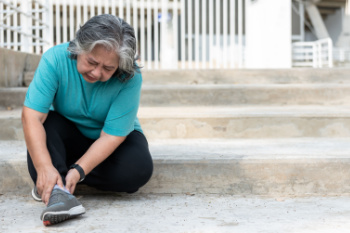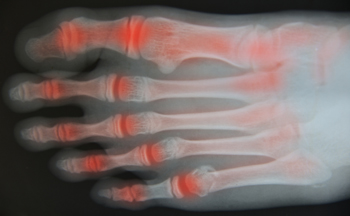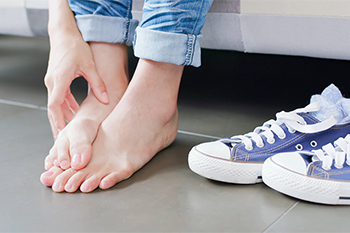Items filtered by date: January 2024
Pain and Ankle Fractures

Ankle fractures can result in significant pain and discomfort, impacting one's daily life and mobility. When an ankle fracture occurs, it usually involves one or more of the ankle bones, including the tibia, fibula, or talus. The severity of pain can vary depending on the type and location of the fracture. Acute pain is a common immediate symptom after an ankle fracture. It typically occurs due to the injury itself, which may involve tearing of ligaments, damage to blood vessels, and nerve irritation. The affected area becomes swollen, bruised, and tender to the touch. Chronic pain may develop as a result of an ankle fracture, especially if it does not heal correctly or if there are complications, such as post-traumatic arthritis. Additionally, chronic pain can persist long after the initial injury and may require ongoing management, including pain medications. Treatment for an ankle fracture may include immobilization, casting, surgery, or other interventions to promote proper healing and alleviate pain. If you have broken your ankle, it is strongly suggested that you schedule an emergency appointment with a podiatrist for a proper diagnosis and treatment.
Broken ankles need immediate treatment. If you are seeking treatment, contact our podiatrists from CNY Foot Surgery & Podiatry Care. Our doctors can provide the care you need to keep you pain-free and on your feet.
Broken Ankles
A broken ankle is experienced when a person fractures their tibia or fibula in the lower leg and ankle area. Both of these bones are attached at the bottom of the leg and combine to form what we know to be our ankle.
When a physician is referring to a break of the ankle, he or she is usually referring to a break in the area where the tibia and fibula are joined to create our ankle joint. Ankles are more prone to fractures because the ankle is an area that suffers a lot of pressure and stress. There are some obvious signs when a person experiences a fractured ankle, and the following symptoms may be present.
Symptoms of a Fractured Ankle
- Excessive pain when the area is touched or when any pressure is placed on the ankle
- Swelling around the area
- Bruising of the area
- Area appears to be deformed
If you suspect an ankle fracture, it is recommended to seek treatment as soon as possible. The sooner you have your podiatrist diagnose the fracture, the quicker you’ll be on the way towards recovery.
If you have any questions, please feel free to contact our office located in East Syracuse, NY . We offer the newest diagnostic and treatment technologies for all your foot care needs.
Symptoms and Treatment of Plantar Warts

Plantar warts, caused by the human papillomavirus, or HPV, are thick, rough skin growths found on the bottom of the foot. While they are benign, the discomfort they can cause is far from trivial. Plantar warts typically form on pressure points such as the heel or ball of the foot, entering the skin through cuts or scratches. Direct contact with an infected surface or person can also lead to their development. Treatment options include keratolytic therapy, cryotherapy, immunotherapy, and laser therapy. In severe cases, surgery is needed. Keratolytic therapy employs acid medication to thin the wart, prompting the outer skin layer's shedding. Cryotherapy involves freezing the wart with liquid nitrogen, creating a red blister that eventually leads to the wart's natural removal. Immunotherapy, using creams or shots, enhances your immune system to combat HPV and eliminate the wart. Laser therapy utilizes focused light to cut away the wart, while surgical removal, performed by numbing the skin and burning the area, becomes necessary in some cases to prevent recurrence. If you have been infected with plantar warts, it is suggested that you schedule an appointment with a podiatrist who can examine your foot and suggest the treatment option that is best for you.
Plantar warts can be very uncomfortable. If you need your feet checked, contact our podiatrists from CNY Foot Surgery & Podiatry Care. Our doctors will assist you with all of your foot and ankle needs.
About Plantar Warts
Plantar warts are the result of HPV, or human papillomavirus, getting into open wounds on the feet. They are mostly found on the heels or balls of the feet.
While plantar warts are generally harmless, those experiencing excessive pain or those suffering from diabetes or a compromised immune system require immediate medical care. Plantar warts are easily diagnosed, usually through scraping off a bit of rough skin or by getting a biopsy.
Symptoms
- Lesions on the bottom of your feet, usually rough and grainy
- Hard or thick callused spots
- Wart seeds, which are small clotted blood vessels that look like little black spots
- Pain, discomfort, or tenderness of your feet when walking or standing
Treatment
- Freezing
- Electric tool removal
- Laser Treatment
- Topical Creams (prescription only)
- Over-the-counter medications
To help prevent developing plantar warts, avoid walking barefoot over abrasive surfaces that can cause cuts or wounds for HPV to get into. Avoiding direct contact with other warts, as well as not picking or rubbing existing warts, can help prevent the further spread of plantar warts. However, if you think you have developed plantar warts, speak to your podiatrist. He or she can diagnose the warts on your feet and recommend the appropriate treatment options.
If you have any questions please feel free to contact our office located in East Syracuse, NY . We offer the newest diagnostic and treatment technologies for all your foot and ankle needs.
Arthritis Can Affect the Feet and Ankles

Arthritis, a chronic inflammatory condition, manifests its influence on the human body in various ways, and the feet and ankles often bear a significant brunt of its impact. The joints in these lower extremities, intricate in structure and essential for mobility, become vulnerable targets. Inflammatory arthritis types, such as rheumatoid arthritis, can result in painful swelling, stiffness, and joint deformities, limiting the range of motion. Osteoarthritis, characterized by the gradual breakdown of cartilage, leads to pain and reduced flexibility in the affected joints. The feet, comprising numerous small joints, are particularly susceptible, and the gradual progression of arthritis can affect the arches, toes, and ankle joints. As these joints endure wear and tear, daily activities can become increasingly challenging. Understanding the toll arthritis can take on the feet and ankles emphasizes the importance of early diagnosis, tailored treatments, and proactive measures. If you have arthritis and your feet and ankles are affected, it is strongly suggested that you consult a podiatrist who can help you to manage this condition.
Arthritis can be a difficult condition to live with. If you are seeking treatment, contact our podiatrists from CNY Foot Surgery & Podiatry Care. Our doctors can provide the care you need to keep you pain-free and on your feet.
Arthritic Foot Care
Arthritis is a joint disorder that involves the inflammation of different joints in your body, such as those in your feet. Arthritis is often caused by a degenerative joint disease and causes mild to severe pain in all affected areas. In addition to this, swelling and stiffness in the affected joints can also be a common symptom of arthritis.
In many cases, wearing ill-fitting shoes can worsen the effects and pain of arthritis. Wearing shoes that have a lower heel and extra room can help your feet feel more comfortable. In cases of rheumatoid arthritis, the arch in your foot may become problematic. Buying shoes with proper arch support that contour to your feet can help immensely.
Alleviating Arthritic Pain
- Exercises that stretch the foot can prevent further pain and injury and increase mobility
- Most of the pain can be alleviated with anti-inflammatory drugs, heat, and topical medications
- Massages can help temporarily alleviate pain.
It is best to see your doctor for the treatment that is right for your needs and symptoms. Conditions vary, and a podiatrist can help you determine the right method of care for your feet.
If you have any questions, please feel free to contact our office located in East Syracuse, NY . We offer the newest diagnostic tools and technology to treat your foot and ankle needs.
Are Bunions Affecting Your Everyday Life?
What Are the Symptoms of Athlete’s Foot?

Athlete's foot, a common fungal infection, unveils a set of unmistakable symptoms that can cause considerable discomfort. The most prevalent sign is persistent itching, often concentrated between the toes. This itching is accompanied by redness and a burning sensation, creating an overall sense of irritation. The skin may peel, crack, or exhibit a scaly appearance, particularly on the soles of the feet. Blisters may also develop, adding another layer of discomfort to this fungal predicament. Foul odor emanating from the infected feet is not uncommon, as the fungus thrives in warm, moist environments. Athlete's foot can spread to the toenails, causing them to thicken and become discolored. Recognizing these symptoms is essential for seeking timely intervention. If you have developed athlete’s foot, it is strongly suggested that you contact a podiatrist. This type of doctor can offer you correct treatment solutions, which may include prescribed medicine.
Athlete’s Foot
Athlete’s foot is often an uncomfortable condition to experience. Thankfully, podiatrists specialize in treating athlete’s foot and offer the best treatment options. If you have any questions about athlete’s foot, consult with our podiatrists from CNY Foot Surgery & Podiatry Care. Our doctors will assess your condition and provide you with quality treatment.
What Is Athlete’s Foot?
Tinea pedis, more commonly known as athlete’s foot, is a non-serious and common fungal infection of the foot. Athlete’s foot is contagious and can be contracted by touching someone who has it or infected surfaces. The most common places contaminated by it are public showers, locker rooms, and swimming pools. Once contracted, it grows on feet that are left inside moist, dark, and warm shoes and socks.
Prevention
The most effective ways to prevent athlete’s foot include:
- Thoroughly washing and drying feet
- Avoid going barefoot in locker rooms and public showers
- Using shower shoes in public showers
- Wearing socks that allow the feet to breathe
- Changing socks and shoes frequently if you sweat a lot
Symptoms
Athlete’s foot initially occurs as a rash between the toes. However, if left undiagnosed, it can spread to the sides and bottom of the feet, toenails, and if touched by hand, the hands themselves. Symptoms include:
- Redness
- Burning
- Itching
- Scaly and peeling skin
Diagnosis and Treatment
Diagnosis is quick and easy. Skin samples will be taken and either viewed under a microscope or sent to a lab for testing. Sometimes, a podiatrist can diagnose it based on simply looking at it. Once confirmed, treatment options include oral and topical antifungal medications.
If you have any questions, please feel free to contact our office located in East Syracuse, NY . We offer the newest diagnostic and treatment technologies for all your foot care needs.
High Heels Can Lead to Foot Deformities

A recent study shows that nearly 40 percent of women wear high heels every day. However, this fashion choice comes at a cost, with 75 percent of these women reporting regular foot pain and various foot deformities. The narrow toe box inherent in most high-heeled shoes is believed to be the main cause. This constrictive design makes it challenging for women to comfortably fit their entire foot into the shoe, leading to toe deformities, such as bunions, hammertoes, and calluses. While heredity plays a large role in the formation of a bunion, external pressure from shoes with a small toe box can make it worse. When conservative measures fail, surgery may be necessary to realign the joint and distribute weight more evenly across the foot. High heels also bend the toes upward, exposing more bone to the bottom of the shoes and causing significant pain. Additionally, the frequent use of high heels is linked to tight calf muscles, which pave the way for other painful foot problems like plantar fasciitis, flat feet, and Achilles tendonitis. For help with any of the above mentioned foot problems, it is suggested that you schedule an appointment with a podiatrist for an exam and treatment options.
High heels have a history of causing foot and ankle problems. If you have any concerns about your feet or ankles, contact our podiatrists from CNY Foot Surgery & Podiatry Care. Our doctors can provide the care you need to keep you pain-free and on your feet.
Effects of High Heels on the Feet
High heels are popular shoes among women because of their many styles and societal appeal. Despite this, high heels can still cause many health problems if worn too frequently.
Which Parts of My Body Will Be Affected by High Heels?
- Ankle Joints
- Achilles Tendon – May shorten and stiffen with prolonged wear
- Balls of the Feet
- Knees – Heels cause the knees to bend constantly, creating stress on them
- Back – They decrease the spine’s ability to absorb shock, which may lead to back pain. The vertebrae of the lower back may compress.
What Kinds of Foot Problems Can Develop from Wearing High Heels?
- Corns
- Calluses
- Hammertoe
- Bunions
- Morton’s Neuroma
- Plantar Fasciitis
How Can I Still Wear High Heels and Maintain Foot Health?
If you want to wear high heeled shoes, make sure that you are not wearing them every day, as this will help prevent long term physical problems. Try wearing thicker heels as opposed to stilettos to distribute weight more evenly across the feet. Always make sure you are wearing the proper shoes for the right occasion, such as sneakers for exercising. If you walk to work, try carrying your heels with you and changing into them once you arrive at work. Adding inserts to your heels can help cushion your feet and absorb shock. Full foot inserts or metatarsal pads are available.
If you have any questions please feel free to contact our office located in East Syracuse, NY . We offer the newest diagnostic and treatment technologies for all your foot and ankle needs.




